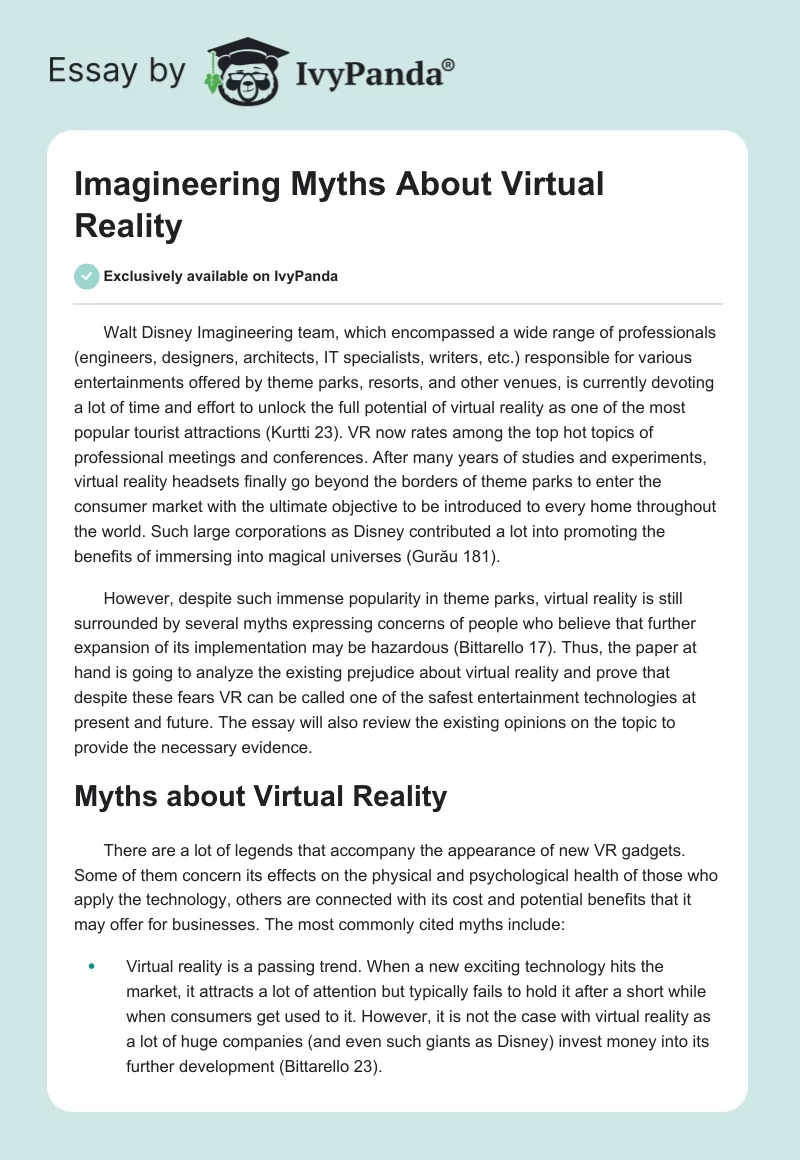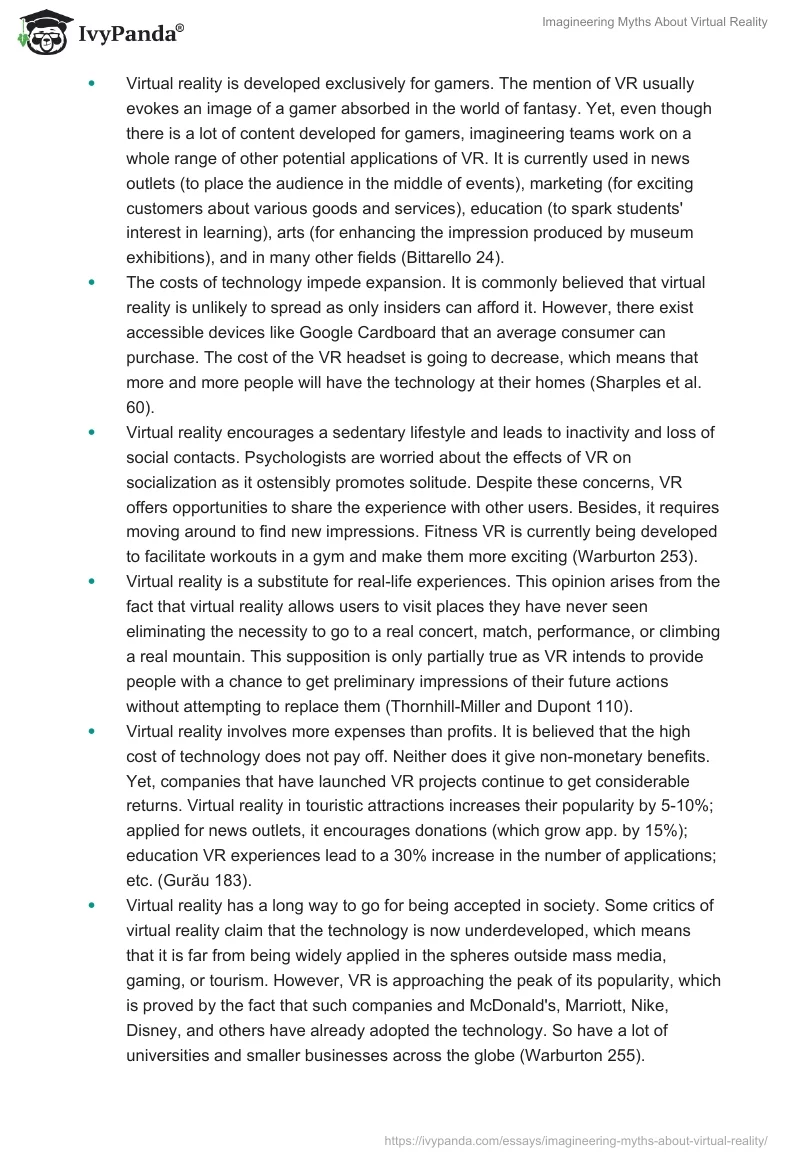Walt Disney Imagineering team, which encompassed a wide range of professionals (engineers, designers, architects, IT specialists, writers, etc.) responsible for various entertainments offered by theme parks, resorts, and other venues, is currently devoting a lot of time and effort to unlock the full potential of virtual reality as one of the most popular tourist attractions (Kurtti 23). VR now rates among the top hot topics of professional meetings and conferences. After many years of studies and experiments, virtual reality headsets finally go beyond the borders of theme parks to enter the consumer market with the ultimate objective to be introduced to every home throughout the world. Such large corporations as Disney contributed a lot into promoting the benefits of immersing into magical universes (Gurău 181).
However, despite such immense popularity in theme parks, virtual reality is still surrounded by several myths expressing concerns of people who believe that further expansion of its implementation may be hazardous (Bittarello 17). Thus, the paper at hand is going to analyze the existing prejudice about virtual reality and prove that despite these fears VR can be called one of the safest entertainment technologies at present and future. The essay will also review the existing opinions on the topic to provide the necessary evidence.
Myths about Virtual Reality
There are a lot of legends that accompany the appearance of new VR gadgets. Some of them concern its effects on the physical and psychological health of those who apply the technology, others are connected with its cost and potential benefits that it may offer for businesses. The most commonly cited myths include:
- Virtual reality is a passing trend. When a new exciting technology hits the market, it attracts a lot of attention but typically fails to hold it after a short while when consumers get used to it. However, it is not the case with virtual reality as a lot of huge companies (and even such giants as Disney) invest money into its further development (Bittarello 23).
- Virtual reality is developed exclusively for gamers. The mention of VR usually evokes an image of a gamer absorbed in the world of fantasy. Yet, even though there is a lot of content developed for gamers, imagineering teams work on a whole range of other potential applications of VR. It is currently used in news outlets (to place the audience in the middle of events), marketing (for exciting customers about various goods and services), education (to spark students’ interest in learning), arts (for enhancing the impression produced by museum exhibitions), and in many other fields (Bittarello 24).
- The costs of technology impede expansion. It is commonly believed that virtual reality is unlikely to spread as only insiders can afford it. However, there exist accessible devices like Google Cardboard that an average consumer can purchase. The cost of the VR headset is going to decrease, which means that more and more people will have the technology at their homes (Sharples et al. 60).
- Virtual reality encourages a sedentary lifestyle and leads to inactivity and loss of social contacts. Psychologists are worried about the effects of VR on socialization as it ostensibly promotes solitude. Despite these concerns, VR offers opportunities to share the experience with other users. Besides, it requires moving around to find new impressions. Fitness VR is currently being developed to facilitate workouts in a gym and make them more exciting (Warburton 253).
- Virtual reality is a substitute for real-life experiences. This opinion arises from the fact that virtual reality allows users to visit places they have never seen eliminating the necessity to go to a real concert, match, performance, or climbing a real mountain. This supposition is only partially true as VR intends to provide people with a chance to get preliminary impressions of their future actions without attempting to replace them (Thornhill-Miller and Dupont 110).
- Virtual reality involves more expenses than profits. It is believed that the high cost of technology does not pay off. Neither does it give non-monetary benefits. Yet, companies that have launched VR projects continue to get considerable returns. Virtual reality in touristic attractions increases their popularity by 5-10%; applied for news outlets, it encourages donations (which grow app. by 15%); education VR experiences lead to a 30% increase in the number of applications; etc. (Gurău 183).
- Virtual reality has a long way to go for being accepted in society. Some critics of virtual reality claim that the technology is now underdeveloped, which means that it is far from being widely applied in the spheres outside mass media, gaming, or tourism. However, VR is approaching the peak of its popularity, which is proved by the fact that such companies and McDonald’s, Marriott, Nike, Disney, and others have already adopted the technology. So have a lot of universities and smaller businesses across the globe (Warburton 255).
Virtual Reality: Evidence from Research
Being rather a controversial point of discussion VR technology inspires a lot of researchers to attempt their investigation of the problem. Some of them provide an alternative view on the VR:
- Warburton, Darren ER. “The Health Benefits of Active Gaming: Separating the Myths from the Virtual Reality.” (2013).
The author of the article states that video gaming is far less harmful to children’s physical and psychological health than it is commonly believed. Moreover, the research attempts to prove that new video games based on virtual reality experience can assist in promoting physical activity and preventing sedentary habits. The purpose of the article is to encourage the application of whole-body gaming for reducing the risks of heart diseases and improving the overall state of health of a wide range of people. Such studies are especially significant as they not only debunk the myths about virtual reality but also provide options for its effective implementation.
- Thornhill-Miller, Branden, and Jean-Marc Dupont. “Virtual Reality and the Enhancement of Creativity and Innovation: Under-Recognized Potential among Converging Technologies?” (2016).
Like in the previous example, researches describe VR as one of the most promising and secure technological trends. They state that VR is a perfect tool for cognitive enhancement helping to develop creative skills, which implies that it must be promoted among educators, trainers, designers, and other professionals. This study is relevant as at present VR is underestimated by those who can make the most it for educating future specialists.
- Gurău, Călin. “Virtual. Reality. Applications in Tourism.” (2007).
The researcher tries to identify, explore, and systematize the present-day applications of VR in tourism. The analysis is performed with the purpose to predict possible directions of development at different stages of the tourist experience. The study is relevant as it can help practitioners increase tourists’ satisfaction.
Conclusion
As any technology that has emerged quite recently, VR provokes a lot of arguments and controversy concerning its potential, safety, and financial benefits. Despite a lot of criticism, the technology proves to be effective in providing advantages in different spheres of human activity including tourism, education, sports, etc., which means that its further development may open new horizons for various sciences.
Works Cited
Bittarello, Maria Beatrice. “Another time, another space: Virtual worlds, myths and imagination.” Journal for Virtual Worlds Research, vol. 1, no. 1, 2008, pp. 13-29.
Gurău, Călin. “Virtual. Reality. Applications in Tourism.” Information and Communication Technologies in Support of the Tourism Industry, vol. 3, no. 2, 2007, pp. 180-194.
Kurtti, Jeff. Walt Disney’s Imagineering Legends and the Genesis of the Disney Theme Park. Disney Editions, 2008.
Sharples, Sarah, et al. “Virtual Reality Induced Symptoms and Effects (VRISE): Comparison of Head Mounted Display (HMD), Desktop and Projection Display Systems.” Displays, vol. 29, no. 2, 2008, pp. 58-69.
Thornhill-Miller, Branden, and Jean-Marc Dupont. “Virtual Reality and the Enhancement of Creativity and Innovation: Under-Recognized Potential Among Converging Technologies?” Journal of Cognitive Education and Psychology, vol. 15, no. 1, 2016, pp. 102-121.
Warburton, Darren ER. “The Health Benefits of Active Gaming: Separating the Myths From the Virtual Reality.” Current Cardiovascular Risk Reports, vol. 7, no. 4, 2013, pp. 251-255.


